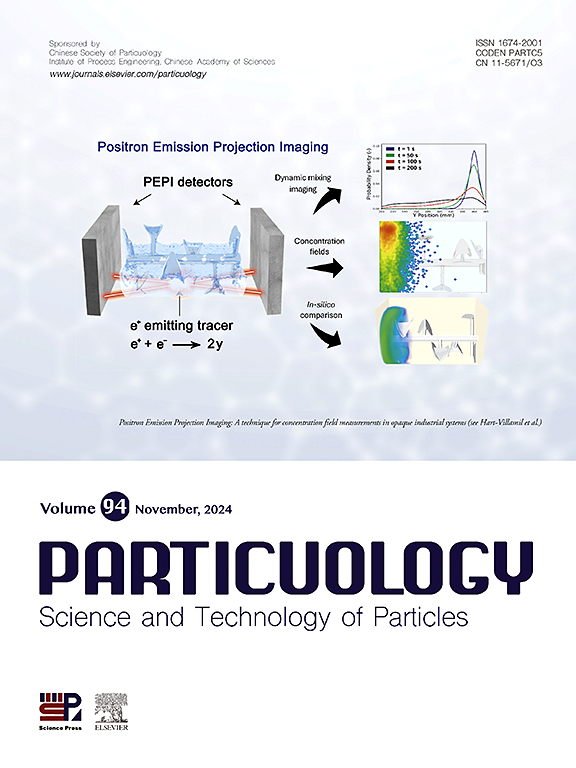颗粒损耗调查以及航空 nvPM 测量方法在宽粒度范围内的适用性
IF 4.1
2区 材料科学
Q2 ENGINEERING, CHEMICAL
引用次数: 0
摘要
国际民用航空组织 (ICAO) 在航空发动机排放法规中规定了非挥发性微粒物质 (nvPM) 的精确测量。然而,评估采样和传输装置中的颗粒损失是一项挑战,引发了对系统可靠性的担忧。此外,推力不超过 26.7 千牛顿的中小型飞机发动机的 nvPM 排放量大小差异很大,增加了测量过程的复杂性。为了全面分析采样和传输子系统中的粒子损失,本研究建立了一个配备纳米粒子发生器的测试台。该发生器模拟了中小型飞机发动机的 nvPM 排放,能够稳定地产生浓度范围(10³-10⁷/cm³)和尺寸分布(20-160 nm)范围广泛的 nvPM。在采样管道内进行了热传导损失验证实验,研究了颗粒大小、温度梯度和气流速度对热传导颗粒损失的影响。实验结果表明,实验结果与联合技术研究中心(UTRC)提出的模型预测结果十分吻合。在对温度进行校正后,实验数据显示,在典型的发动机排气条件下,最大差异为 2%,验证了热泳损失模型对各种类型发动机的可预测性。此外,还进行了颗粒扩散和弯曲损失的验证实验。与 UTRC 模型的对比分析表明,在低雷诺数 (Re) 的层流条件下,nvPM 存在惯性沉积。随着雷诺数的增加,测量数据与模拟数据更加接近。二次流动模式导致的弯曲损失在 1% 到 10% 之间,具体取决于颗粒大小和流速。这一发现支持了航空 nvPM 测量方法在宽粒度范围内的适用性。这项研究为未来在各种飞机发动机上进行 nvPM 测量提供了理论支持,为提高排放监测的准确性和可靠性奠定了基础。本文章由计算机程序翻译,如有差异,请以英文原文为准。

Investigation on the particle loss and applicability of aviation nvPM measurement methodology for wide particle size ranges
The precise measurement of non-volatile Particulate Matter (nvPM) is outlined in aviation engine emissions regulations by the International Civil Aviation Organization (ICAO). However, assessing particle losses in the sampling and transfer unit presents challenges, raising concerns about the system's reliability. Moreover, nvPM emissions from small and medium aircraft engines, with thrust not exceeding 26.7 kN, vary widely in size, adding complexity to the measurement process. To provide a comprehensive analysis of particle losses in the sampling and transfer subsystems, this study established a test bench equipped with a nanoparticle generator. The generator simulates nvPM emissions from medium and small aircraft engines and can consistently produce nvPMs with a wide range of concentrations (10³-10⁷/cm³) and size distributions (20–160 nm). Thermophoretic loss verification experiments were conducted within the sampling pipeline under significant temperature differences, investigating the effects of particle size, temperature gradient, and airflow rate on thermophoretic particle losses. The experimental results demonstrated good agreement with the predictions of the model proposed by United Technologies Research Centre (UTRC). After correcting for temperature, the experimental data showed a maximum disparity of 2% under typical engine exhaust conditions, validating the predictability of the thermophoretic loss model for various engine types. Furthermore, verification experiments for particle diffusion and bending losses were performed. Comparative analysis with the UTRC model revealed nvPM inertial deposition under laminar flow conditions with low Reynolds numbers (Re). As the Re increased, the measured data more closely aligned with the simulations. Bending losses due to secondary flow patterns ranged from 1% to 10%, depending on particle size and flow rate. This finding supports the applicability of aviation nvPM measurement methods across a wide particle size range. This research provides theoretical support for future nvPM measurements on various aircraft engines, laying the groundwork for improved accuracy and reliability in emissions monitoring.
求助全文
通过发布文献求助,成功后即可免费获取论文全文。
去求助
来源期刊

Particuology
工程技术-材料科学:综合
CiteScore
6.70
自引率
2.90%
发文量
1730
审稿时长
32 days
期刊介绍:
The word ‘particuology’ was coined to parallel the discipline for the science and technology of particles.
Particuology is an interdisciplinary journal that publishes frontier research articles and critical reviews on the discovery, formulation and engineering of particulate materials, processes and systems. It especially welcomes contributions utilising advanced theoretical, modelling and measurement methods to enable the discovery and creation of new particulate materials, and the manufacturing of functional particulate-based products, such as sensors.
Papers are handled by Thematic Editors who oversee contributions from specific subject fields. These fields are classified into: Particle Synthesis and Modification; Particle Characterization and Measurement; Granular Systems and Bulk Solids Technology; Fluidization and Particle-Fluid Systems; Aerosols; and Applications of Particle Technology.
Key topics concerning the creation and processing of particulates include:
-Modelling and simulation of particle formation, collective behaviour of particles and systems for particle production over a broad spectrum of length scales
-Mining of experimental data for particle synthesis and surface properties to facilitate the creation of new materials and processes
-Particle design and preparation including controlled response and sensing functionalities in formation, delivery systems and biological systems, etc.
-Experimental and computational methods for visualization and analysis of particulate system.
These topics are broadly relevant to the production of materials, pharmaceuticals and food, and to the conversion of energy resources to fuels and protection of the environment.
 求助内容:
求助内容: 应助结果提醒方式:
应助结果提醒方式:


